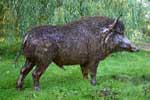 English Mode of Hunting, and Indian Pig-Sticking: The hunting of the wild boar has been in all times, and in all countries, a pastime of the highest interest and excitement, and from the age of Nimrod, has only been considered second to the more dangerous sport of lion-hunting. The buried treasures of Nineveh, restored to us by Mr. Layard, show us, on their sculptured annals, the kings of Assyria in their royal pastime of boar-hunting. That the Greeks were passionately attached to this sport, we know both from history and the romantic fables of the poets. Marc Antony, at one of his breakfasts with Cleopatra, had _eight wild boars_ roasted whole; and though the Romans do not appear to have been addicted to hunting, wild-boar fights formed part of their gladiatorial shows in the amphitheatre. In France, Germany, and Britain, from the earliest time, the boar-hunt formed one of the most exciting of sports; but it was only in this country that the sport was conducted without dogs,--a real hand-to-hand contest of man and beast; the hunter, armed only with a boar-spear, a weapon about four feet long, the ash staff, guarded by plates of steel, and terminating in a long, narrow, and very sharp blade: this, with a hunting-knife, or hanger, completed his offensive arms. Thus equipped, the hunter would either encounter his enemy face to face, confront his desperate charge, as with erect tail, depressed head, and flaming eyes, he rushed with his foamy tusks full against him, who either sought to pierce his vitals through his counter, or driving his spear through his chine, transfix his heart; or failing those more difficult aims, plunge it into his flank, and, without withdrawing the weapon, strike his ready hanger into his throat. But expert as the hunter might be, it was not often the formidable brute was so quickly dispatched; for he would sometimes seize the spear in his powerful teeth, and nip it off like a reed, or, coming full tilt on his enemy, by his momentum and weight bear him to the earth, ripping up, with a horrid gash, his leg or side, and before the writhing hunter could draw his knife, the infuriated beast would plunge his snout in the wound, and rip, with savage teeth, the bowels of his victim. At other times, he would suddenly swerve from his charge, and doubling on his opponent, attack the hunter in the rear. From his speed, great weight, and savage disposition, the wild boar is always a dangerous antagonist, and requires great courage, coolness, and agility on the part of the hunter. The continental sportsman rides to the chase in a cavalcade, with music and dogs,--a kind of small hound or mastiff, and leaving all the honorary part of the contest to them, when the boar is becoming weary, and while beset by the dogs, rides up, and drives his lance home in the beast's back or side. Boar-hunting has been for some centuries obsolete in England, the animal no longer existing in a wild state among us; but in our Indian empire, and especially in Bengal, the pastime is pursued by our countrymen with all the daring of the national character; and as the animal which inhabits the cane-brakes and jungles is a formidable foe, the sport is attended with great excitement. The hunters, mounted on small, active horses, and armed only with long lances, ride, at early daylight, to the skirts of the jungle, and having sent in their attendants to beat the cover, wait till the tusked monster comes crashing from among the canes, when chase is immediately given, till he is come up with, and transfixed by the first weapon. Instead of flight, however, he often turns to bay, and by more than one dead horse and wounded hunter, shows how formidable he is, and what those polished tusks, sharp as pitch-forks, can effect, when the enraged animal defends his life. |

Search |
Food and Farming PageBoar |  |
Deer  |
| Comments (0) | Don't be shy, tell us what you think! → |
Colonial Sense is an advocate for global consumer privacy rights, protection and security.
All material on this website © copyright 2009-24 by Colonial Sense, except where otherwise indicated.
ref:T5-S39-P936-C-M
All material on this website © copyright 2009-24 by Colonial Sense, except where otherwise indicated.
ref:T5-S39-P936-C-M


